Early winter drama at the bird feeder
Donald McClure | Jan 09, 2013 | Comments 6
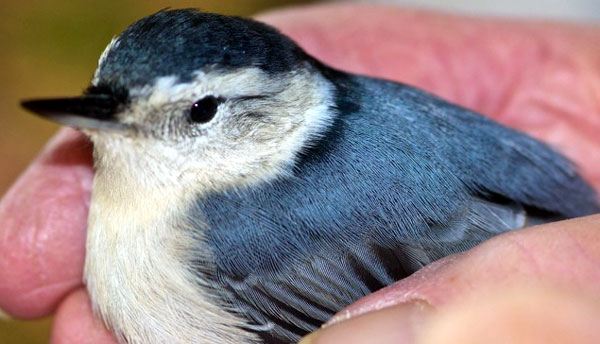
Recovering from a nasty collision with a glass door, White-breasted Nuthatch recovers in the writer’s hand until he is ready to fly back to his favourite maple under his own power. Judith McClure photo
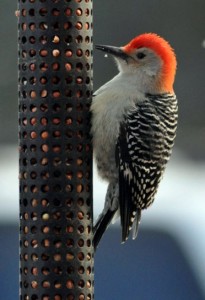
Star of our current winter bird feeding station is this pompous, bad-tempered, but seductive Red-bellied Woodpecker. Donald McClure photo
If snowbound humans require inspiration to help survive the winter they need only look outside to their bird feeders. The sight of these frail birds of winter, hopping in the cold on their pencil-thin legs, the bitter, merciless winds rustling their thin feathers, should should take away any urge to complain about our own plight.
How they are able to survive? Not only the elements, but a shortage of foods and the constant surveillance of raptors and feral cats, is astounding. Somehow, with a little help from their friends, many persevere and find their way into spring. And we can only look in wonder.
Well, before the holiday season the winter roster at our bird feeding station had been pretty well established and the birds of spring, summer and autumn had been replaced or augmented by the seemingly tougher-skinned birds of winter.
Three families of orioles and their summer hummer companions had vanished by the first week in September and the new king of the garden was the dramatic, skittish and irritable Red-bellied woodpecker.
Gradually, many of the niger seed scoffing American Gold finches had been largely replaced by a cluster of nomadic pine Siskins and a couple of purple finches. On the ground, pairs of Juncos, Tree Sparrows, Purple Finches, House Sparrows, and a gorgeous pair of Cardinals would show up on the periphery to peck up seeds scattered from the activity above. Up to six Blue Jays came daily to carry off hidden peanuts and our Mourning Dove contingent listed 16 on its roster.
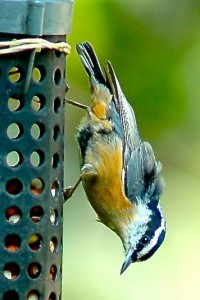
Doughty Red-breasted Nuthatch makes up for his tiny size by his aggressive attitude. Donald McClure photo
All seemed well until the November afternoon when usually calm and aloof Norman the White-breasted Nuthatch blasted off his perch on the peanuts and soared straight into the porch sliding doors. There he lay in trembling glory on the outdoor carpet, his throbbing and vibrating wings fanned out, his eyes glazed, his head drooping….
We love this guy and his girl friends and fearing the worst, I sprang into action, talking quietly to him, I slid one hand under his chest and dropped the other hand over his back, his sagging head between my fingers. His eyes were closing, his body in shock. After a moment or two in my warm hand, his body relaxed, then I felt his ample feet grasping for a perch. He discovered my middle finger and held onto it for dear life. Gently I took him inside out of the wind. In a few minutes the glazed look vanished from his eyes. I could feel his little heart beating against my skin.
As soon as I felt him straining a little in my hand I returned outside. Within minutes I opened up my fingers and he released my finger. He inched up on top of my hand, started to pay attention the the world around him, and within a minute or two, he drew himself together and flew to a branch on the maple behind the house.
Over the years I have found that this hold and release technique seems to offer protection and warmth for the helpless bird, maintaining its body temperature on cool days and allowing it a secure shelter to recover its wits and plan its next venture out.
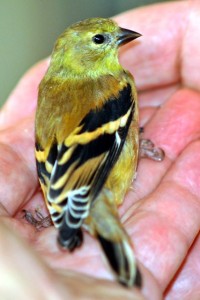
Having regained his focus, the Siskin waits until his head clears before barrelling off to get back into the daily routine centered around the feeding station. Judith McClure photo
About a week later the same problem occurred with a Pine Siskin who really looked stunned initially but recovered fully in about five minutes and flew strongly away. Faced with a similar problem, I would recommend the same gentle technique to give the bird a fighting chance for survival.
So, keep feeders clean and tidy and amply stocked with fresh food. Most popular foods at our station include black oil seed, niger seed, peanuts (in the shell or out) and a general mix that includes sunflower seeds, millet and again black oil seeds.
Filed Under: Featured Articles
About the Author: He can tickle your funny bone or tug at your heart strings. County people may know him as a chronicler of everything that happens (or should happen) in the garden, but his interests stretch across the natural world. His unique sense of observation takes in a wide expanse of living and may even point out some truths about our own condition as managers of the world around us. With Loyalist antecedents in his family tree his roots go deep into the Ontario countryside.




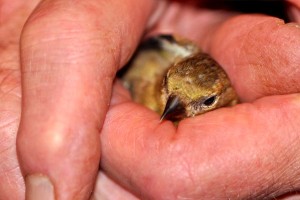






























Great idea Doris. We will spread the word. Many thanks, Regards Donald
Hi Donald,
We’ve been watching, like you, the usual birds at our feeders, as well as a Carolina wren that comes usually at first light, and seems to prefer the peanuts over seeds, slamming it’s beak onto them to break them up, chasing them over the deck boards. We also have a cardinal couple – I much prefer the females for their subtle beauty, rather than the bold, brashness of the brilliant red male – and have also had plenty of song sparrows and common red-poles.
I smiled at your recount of holding the bird in your hand to aid it in recovering itself, as it made me recall several years ago, when a pileated woodpecker ran into our large picture window and lay stunned on the grass. Can you imagine trying to hold that in your hands, ha ha! What we did do, was gently wrap it in a sweater – which it was fine with – and took it into the laundry room, and set it under the laundry basket, overturned. The many holes of course gave it plenty of air. We closed the door and let it regain its composure. We knew when it was ready to go, from the shuffling sounds coming from behind that door. We opened the window, took out the screen, and on the count of three…whoosh! Away it flew out into the backyard into the tall cedar tree! It was a gratifying moment.
Thank you Doris. The Wooler bird store has some excellent and innovative birding supplies for sure. We installed some wooden fish silhouettes with glass marbles inserted on some of our windows to help birds distinquish the glass barrier.
Regards Donald
Thank you Chris. Audubon’s advice is always worth putting into practice. Despite the two incidents described, we have not had any fatal bird strikes with the present feeder location in 20 years of operating — with the exception of an American Kestrel who dived out of a maple tree into the glass doors one cold morning.
“Many birds strike windows after being startled off a feeder. Bird feeders placed within three feet of windows can reduce fatal collisions because birds do not have an adequate distance to reach high flight velocity. Placing the feeders more than 30 feet from a window will also reduce window collision risk because, at that distance, birds are more likely to recognize that the reflected image is part of a house and are less likely to fly toward it for safety.” – Audubon Society
See: http://web4.audubon.org/bird/at_home/SafeWindows.html
for the efficacy of other solutions.
Janet K purchased some interesting decals at the bird store in Wooler and they have not had birds hitting their windows since. I am going to go up and get some.